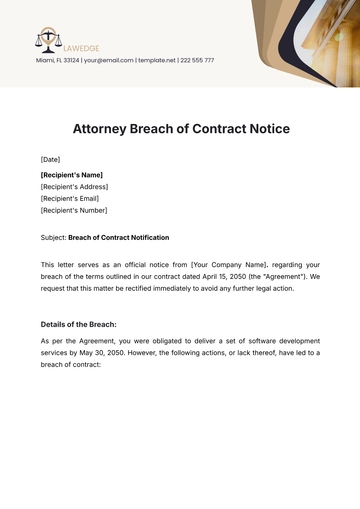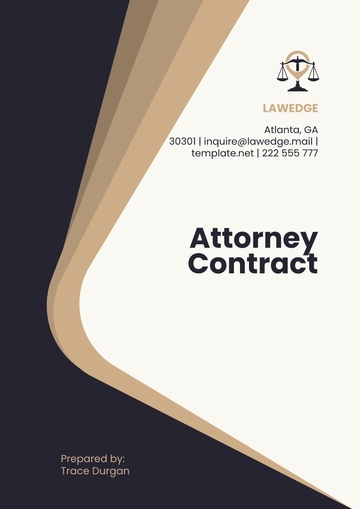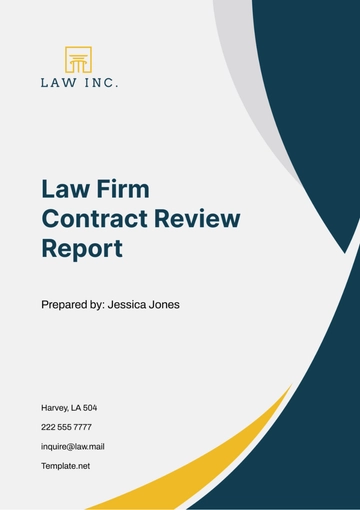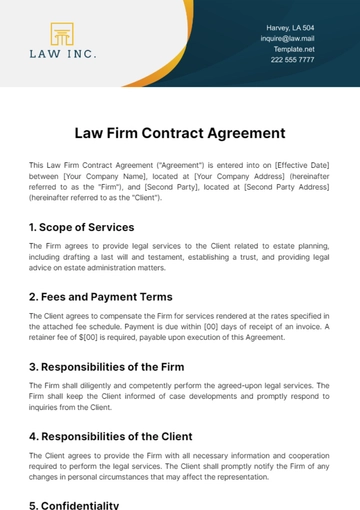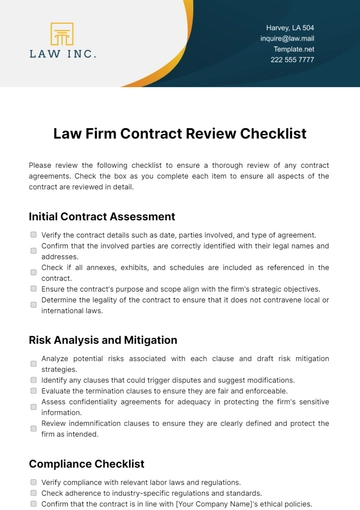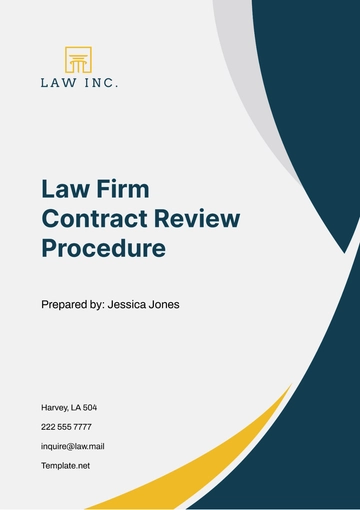Free Legal Crisis Management Contractual Agreements Protocol
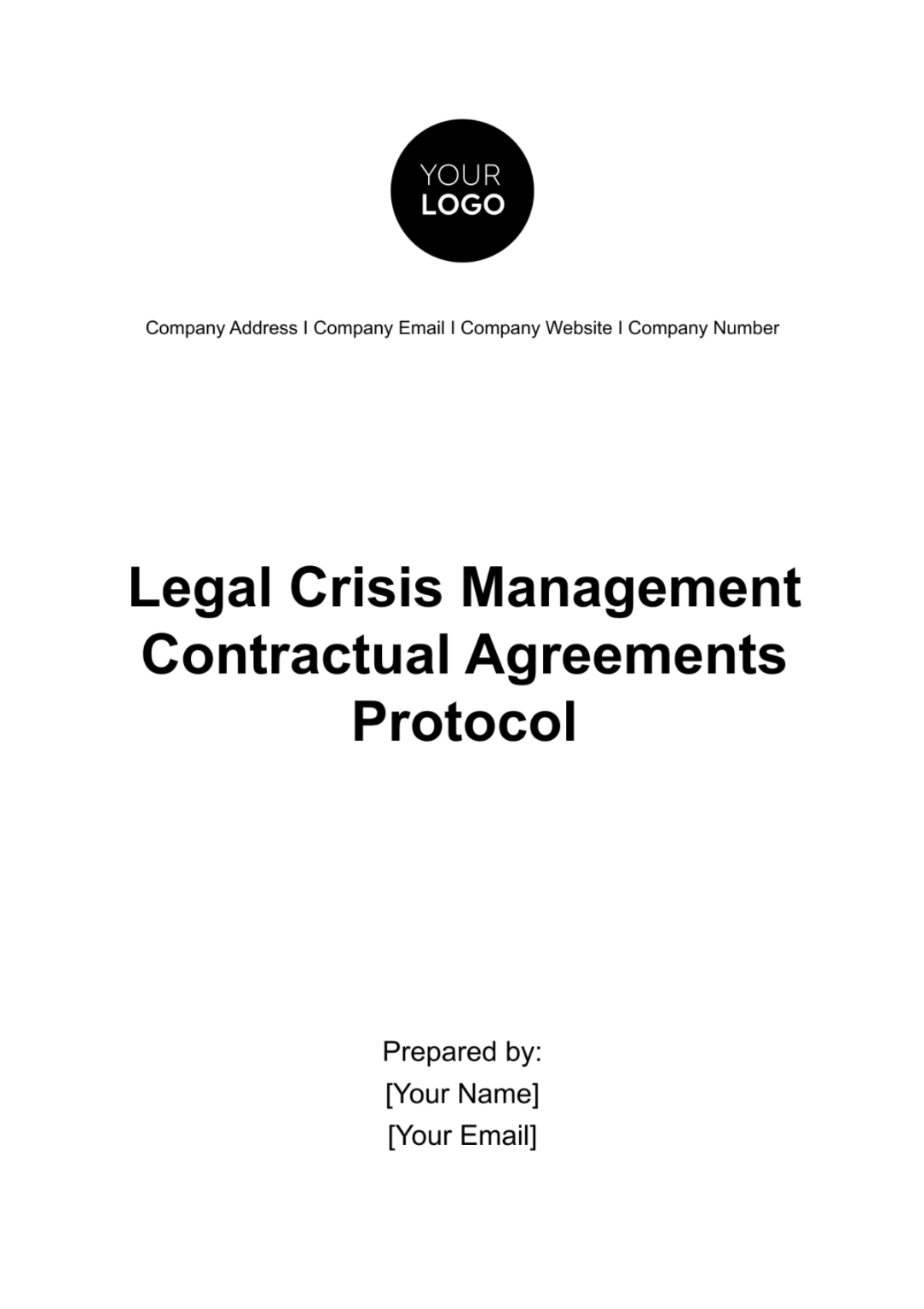
I. Introduction
A. Purpose of the Protocol
The purpose of this protocol is to provide a structured and comprehensive framework for effectively managing legal crises that may arise from contractual agreements within [Your Company Name]. By establishing clear guidelines and procedures, this protocol aims to facilitate timely and coordinated responses to mitigate legal risks and safeguard the interests of the organization and its stakeholders. It serves as a proactive measure to enhance the organization's resilience in addressing potential legal challenges and ensuring compliance with contractual obligations.
B. Scope and Applicability
This protocol applies to all contractual agreements entered into by [Your Company Name], encompassing a wide range of relationships such as vendor contracts, service agreements, partnership agreements, and client contracts. It is designed to be flexible yet comprehensive, accommodating various types of contracts and potential legal crises that may arise throughout the duration of these agreements. All employees, contractors, and stakeholders involved in the execution or management of contractual agreements are expected to adhere to the guidelines outlined in this protocol.
C. Definitions and Terminology
1. Crisis: Any event or circumstance that poses a significant legal risk or threatens the organization's contractual obligations, potentially resulting in financial, reputational, or operational consequences.
2. Crisis Management Team: A designated group of individuals responsible for implementing this protocol and managing legal crises, composed of representatives from relevant departments, including legal, risk management, communications, and executive leadership.
3. Legal Counsel: Attorneys or legal advisors retained by [Your Company Name] to provide legal representation and guidance during crises, ensuring that the organization's actions align with legal requirements and best practices.
II. Crisis Identification and Assessment
A. Early Warning Signs
Early warning signs of potential legal crises include significant breaches of contract, indications of non-compliance with contractual obligations or regulatory requirements, and emerging disputes or conflicts with counterparties. It is essential for employees and stakeholders to remain vigilant and promptly report any indicators of potential legal issues to the Crisis Management Team for assessment and action.
B. Crisis Response Team Formation
The Crisis Management Team is formed promptly upon identification of a potential crisis, consisting of designated representatives from relevant departments and disciplines. The team leader and communication coordinator are appointed to facilitate efficient decision-making and information dissemination throughout the crisis response process.
C. Initial Crisis Assessment
Upon formation, the Crisis Management Team conducts an initial assessment of the crisis, gathering relevant information and conducting a preliminary analysis of its impact and severity. This assessment involves evaluating the legal risks associated with the crisis, identifying potential liabilities, and assessing the organization's exposure.
D. Risk Analysis
A comprehensive risk analysis is conducted to understand the nature and magnitude of legal risks posed by the crisis. This analysis considers various factors, including contractual obligations, regulatory compliance, potential legal claims, and reputational concerns. The findings of the risk analysis inform subsequent decision-making and response strategies adopted by the Crisis Management Team.
III. Communication Strategy
A. Internal Communication Protocol
The internal communication protocol outlines clear roles and responsibilities for key personnel involved in managing the crisis, including the CEO, legal counsel, and department heads. It establishes communication channels and procedures for sharing information, making decisions, and coordinating actions within the organization.
B. External Communication Protocol
The external communication protocol defines strategies for managing communication with external stakeholders, including the media, regulatory authorities, clients, partners, and vendors. It outlines procedures for crafting and disseminating consistent messages, addressing inquiries and concerns, and maintaining transparency while protecting sensitive information.
IV. Legal Representation and Consultation
A. Engagement of Legal Counsel
Engaging experienced legal counsel is critical to navigate the complexities of legal crises effectively. [Your Company Name] will select legal representatives based on their expertise in relevant practice areas and track record in crisis management. Clear engagement terms and agreements will be established to define the scope of legal representation and ensure alignment with organizational objectives.
B. Attorney-Client Privilege and Confidentiality
Upholding attorney-client privilege and confidentiality is paramount to protect sensitive information and preserve legal strategies. All communications between [Your Company Name] and its legal counsel will be treated as confidential, safeguarding privileged information from disclosure to third parties. Strict protocols will be implemented to maintain confidentiality, including secure communication channels and access controls.
C. Legal Risk Analysis and Strategy Development
Legal counsel will collaborate with [Your Company Name] to conduct a comprehensive risk analysis and develop tailored strategies to address legal crises. This includes assessing potential liabilities, evaluating legal options, and formulating proactive approaches to mitigate risks. Through close collaboration and strategic planning, the organization aims to minimize legal exposure and achieve favorable outcomes in crisis situations.
V. Regulatory Compliance
A. Compliance Review and Assessment
[Your Company Name] will conduct regular reviews and assessments to ensure compliance with relevant laws, regulations, and contractual obligations. This includes comprehensive audits of internal processes and controls to identify areas of non-compliance and potential regulatory risks. By staying abreast of regulatory requirements, the organization can proactively address compliance issues and mitigate associated legal risks.
B. Interaction with Regulatory Authorities
In the event of regulatory scrutiny or enforcement actions, [Your Company Name] will engage in transparent and cooperative interactions with regulatory authorities. This includes timely reporting of compliance concerns, providing requested information, and participating in regulatory investigations or proceedings. Open communication and cooperation with regulatory agencies are essential to demonstrate commitment to compliance and resolve issues effectively.
C. Compliance Monitoring and Reporting
[Your Company Name] will establish robust monitoring mechanisms to track compliance status and identify emerging regulatory risks. Regular reporting procedures will be implemented to keep senior management and relevant stakeholders informed of compliance efforts and any significant developments. By maintaining proactive oversight of compliance activities, the organization can promptly address compliance gaps and mitigate potential legal consequences.
VI. Contractual Obligations
A. Review of Relevant Contracts and Agreements
[Your Company Name] will conduct a thorough review of all relevant contracts and agreements implicated in the crisis. This includes analyzing contractual terms, obligations, and provisions to assess the organization's rights and liabilities. By gaining a clear understanding of contractual obligations, the organization can develop informed strategies for addressing the crisis and protecting its interests.
B. Breach of Contract Analysis
In cases where a breach of contract is identified, [Your Company Name] will conduct a detailed analysis to determine the severity and implications of the breach. This analysis will involve assessing the extent of the breach, its impact on contractual relationships, and the available remedies under the contract. By accurately evaluating breach scenarios, the organization can pursue appropriate courses of action to mitigate damages and enforce contractual rights.
C. Contractual Remedies and Dispute Resolution Mechanisms
[Your Company Name] will explore available contractual remedies and dispute resolution mechanisms to address the crisis effectively. This may include seeking damages, enforcing specific performance clauses, or engaging in negotiation, mediation, or arbitration processes with contractual counterparties. By leveraging contractual provisions and alternative dispute resolution mechanisms, the organization aims to resolve disputes efficiently and preserve business relationships where possible.
VII. Documentation and Record-Keeping
A. Document Preservation Protocol
[Your Company Name] will establish protocols for the preservation of relevant documents and evidence related to the crisis. This includes implementing procedures for document collection, storage, and retention to ensure their integrity and admissibility in legal proceedings. By adhering to document preservation protocols, the organization can protect critical evidence and support its legal defense or claims.
B. Record-Keeping Requirements
Comprehensive record-keeping requirements will be implemented to document all communication, decisions, and actions taken during the crisis management process. This includes maintaining detailed records of meetings, correspondence, and any other relevant documentation. By maintaining accurate and comprehensive records, [Your Company Name] can demonstrate transparency, accountability, and compliance with legal obligations.
C. Document Retention Policies
[Your Company Name] will establish document retention policies to govern the retention and disposal of records in accordance with legal and regulatory requirements. This includes defining retention periods for different types of documents based on their significance and relevance to the organization. By adhering to document retention policies, the organization can manage its records efficiently, mitigate legal risks associated with improper document disposal, and ensure compliance with legal obligations.
VIII. Escalation Procedures
A. Escalation Matrix
[Your Company Name] will establish an escalation matrix outlining hierarchical procedures for escalating crisis severity levels. This matrix will define criteria for determining when to escalate crisis management efforts and the appropriate response at each escalation level. By establishing clear escalation pathways, the organization can ensure timely and effective decision-making in response to evolving crisis situations.
B. Decision-Making Authority
Clear guidelines will be established regarding decision-making authority at each escalation level within the organization. This includes defining roles and responsibilities for key decision-makers and establishing thresholds for delegating authority as crises escalate. By clarifying decision-making authority, [Your Company Name] can streamline crisis response efforts and facilitate swift action when necessary.
C. Emergency Response Protocol
[Your Company Name] will develop an emergency response protocol to guide immediate actions in high-stakes crisis scenarios. This protocol will outline procedures for activating emergency response teams, coordinating with external stakeholders, and implementing crisis management measures to mitigate immediate threats. By preparing for emergency situations in advance, the organization can minimize potential damage and ensure the safety of personnel and assets.
IX. Remediation and Mitigation
A. Remedial Action Plan
[Your Company Name] will develop a remedial action plan to address immediate concerns and mitigate the impact of the crisis. This plan will include specific actions, timelines, and responsibilities assigned to relevant stakeholders for implementing remedial measures. By implementing a structured action plan, the organization can respond effectively to crisis situations and minimize adverse effects on operations and reputation.
B. Risk Mitigation Strategies
[Your Company Name] will implement risk mitigation strategies to prevent future crises and reduce the likelihood of recurrence. This may involve implementing controls, safeguards, or process improvements to address underlying causes of the crisis and strengthen resilience against similar events. By proactively addressing root causes and vulnerabilities, the organization can enhance its ability to manage risks effectively and sustain long-term success.
C. Continuous Improvement Process
[Your Company Name] will establish a continuous improvement process to review and enhance crisis management practices based on lessons learned from past experiences. This process will involve conducting post-crisis debriefings, analyzing performance metrics, and soliciting feedback from stakeholders to identify areas for improvement. By embracing a culture of continuous learning and adaptation, the organization can refine its crisis management capabilities and enhance readiness to respond to future challenges.
X. Training and Awareness
A. Crisis Management Training
[Your Company Name] will provide comprehensive training programs to equip employees with the knowledge and skills necessary to effectively respond to legal crises. These training sessions will cover crisis identification, communication strategies, decision-making protocols, and other relevant topics. By investing in employee training, the organization can enhance overall preparedness and resilience in managing legal crises.
B. Stakeholder Awareness Programs
[Your Company Name] will conduct awareness programs to educate stakeholders about the organization's crisis management protocols and procedures. This may include disseminating informational materials, conducting seminars or workshops, and facilitating open dialogue sessions with stakeholders. By promoting stakeholder awareness, the organization can foster transparency, trust, and collaboration in crisis response efforts.
C. Tabletop Exercises and Simulation Drills
[Your Company Name] will conduct tabletop exercises and simulation drills to test the effectiveness of crisis management protocols in a controlled environment. These exercises will simulate various crisis scenarios, allowing teams to practice response procedures, decision-making, and coordination. By conducting regular drills, the organization can identify gaps, refine protocols, and improve overall preparedness to handle real-life crisis situations.
XI. Review and Evaluation
A. Post-Crisis Debriefing
Following the resolution of a crisis, [Your Company Name] will conduct post-crisis debriefing sessions to review response efforts and identify lessons learned. These sessions will involve stakeholders from relevant departments and external partners, facilitating open discussion and feedback. By reflecting on the crisis response process, the organization can identify strengths, weaknesses, and areas for improvement.
B. Lessons Learned Analysis
[Your Company Name] will conduct a comprehensive analysis of lessons learned from past crisis experiences to inform future improvements. This analysis will involve identifying root causes of crises, evaluating the effectiveness of response measures, and documenting key insights and recommendations. By leveraging lessons learned, the organization can enhance its crisis management capabilities and minimize the likelihood of recurrence.
C. Protocol Review and Revision
[Your Company Name] will regularly review and revise the crisis management protocol to incorporate lessons learned, changes in regulatory requirements, and emerging best practices. This iterative process will involve soliciting feedback from stakeholders, conducting gap analyses, and updating protocols accordingly. By maintaining a dynamic and adaptive approach to protocol development, the organization can ensure its crisis management practices remain robust and effective over time.
XII. Conclusion
A. Protocol Implementation and Monitoring
[Your Company Name] is committed to implementing and monitoring the crisis management protocol to enhance organizational resilience and mitigate legal risks. This includes ensuring adherence to protocol guidelines, tracking key performance indicators, and continuously assessing protocol effectiveness.
B. Continuous Improvement and Adaptation
[Your Company Name] recognizes the importance of continuous improvement and adaptation in crisis management practices. By embracing a culture of learning and innovation, the organization will remain proactive in addressing evolving legal challenges and optimizing crisis response capabilities.
C. Contact Information for Crisis Management Team Members
Contact information for key members of the Crisis Management Team is provided below for easy accessibility during crisis situations. This includes designated contacts for legal counsel, crisis communication, and other relevant stakeholders.
- 100% Customizable, free editor
- Access 1 Million+ Templates, photo’s & graphics
- Download or share as a template
- Click and replace photos, graphics, text, backgrounds
- Resize, crop, AI write & more
- Access advanced editor
Discover the ultimate solution for legal crisis management with the Legal Crisis Management Contractual Agreements Protocol Template from Template.net. This editable and customizable template offers a comprehensive framework for navigating contractual crises seamlessly. With our AI Editor Tool, effortlessly tailor the protocol to your organization's needs, ensuring swift and effective crisis response every time.
You may also like
- Rental Contract
- Contractor Contract
- Contract Agreement
- One Page Contract
- School Contract
- Social Media Contract
- Service Contract
- Business Contract
- Restaurant Contract
- Marketing Contract
- Real Estate Contract
- IT Contract
- Cleaning Contract
- Property Contract
- Supplier Contract
- Partnership Contract
- Food Business Contract
- Construction Contract
- Employment Contract
- Investment Contract
- Project Contract
- Payment Contract
- Student Contract
- Travel Agency Contract
- Startup Contract
- Annual Maintenance Contract
- Employee Contract
- Gym Contract
- Event Planning Contract
- Personal Contract
- Nursing Home Contract
- Law Firm Contract
- Work from Home Contract
- Software Development Contract
- Maintenance Contract
- Music Contract
- Amendment Contract
- Band Contract
- DJ Contract
- University Contract
- Salon Contract
- Renovation Contract
- Photography Contract
- Lawn Care Contract
